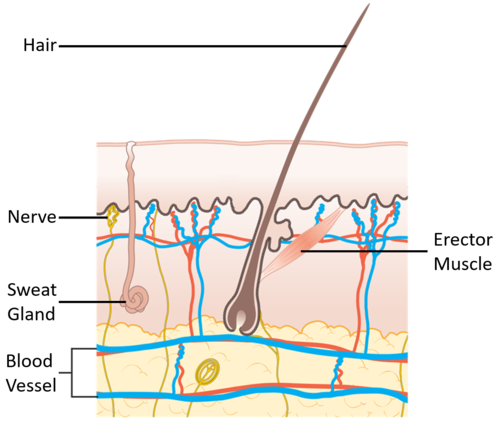Difference between revisions of "Thermoregulation"
(→About Thermoregulation) |
|||
| Line 11: | Line 11: | ||
*[[Blood Vessel|Blood vessels]] near the surface of the [[skin]] [[dilate]] to allow more of the warm [[blood]] to pass its [[Thermal Energy Store|thermal energy]] on to the [[skin]]. | *[[Blood Vessel|Blood vessels]] near the surface of the [[skin]] [[dilate]] to allow more of the warm [[blood]] to pass its [[Thermal Energy Store|thermal energy]] on to the [[skin]]. | ||
| − | When the [[Body Temperature|body temperature]] is too low | + | When the [[Body Temperature|body temperature]] is too low: |
*[[Sweat Gland|Sweat glands]] stop [[secrete|secreting]] [[sweat]] and the [[skin]] becomes dry. | *[[Sweat Gland|Sweat glands]] stop [[secrete|secreting]] [[sweat]] and the [[skin]] becomes dry. | ||
*[[Erector Muscle|Erector muscles]] contract causing body hairs to stand on end. This creates a pocket of trapped air under the hairs which insulates the body. | *[[Erector Muscle|Erector muscles]] contract causing body hairs to stand on end. This creates a pocket of trapped air under the hairs which insulates the body. | ||
Revision as of 15:04, 5 April 2019
Key Stage 4
Meaning
Thermoregulation is the process of keeping the temperature inside an organism constant.
About Thermoregulation
- Thermoregulation is a type of homeostasis.
- Thermoregulation is controlled by the skin.
When the body temperature is too high:
- Sweat glands on the skin secrete sweat which evaporates from the skin cooling it down.
- Erector muscles relax allowing the body hairs to lie flat on the skin.
- Blood vessels near the surface of the skin dilate to allow more of the warm blood to pass its thermal energy on to the skin.
When the body temperature is too low:
- Sweat glands stop secreting sweat and the skin becomes dry.
- Erector muscles contract causing body hairs to stand on end. This creates a pocket of trapped air under the hairs which insulates the body.
- Blood vessels near the surface of the skin constrict reducing blood flow close to the skin preventing thermal energy being lost to the skin.
- Muscles throughout the body begin to shake. This is called shivering.
| A diagram showing the features of the skin involved in thermoregulation. |
